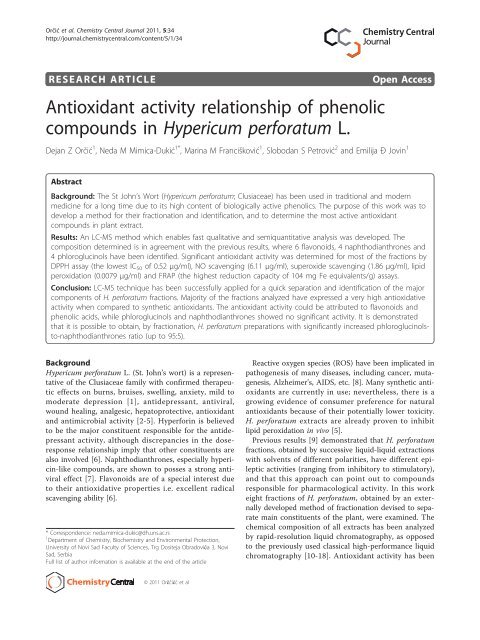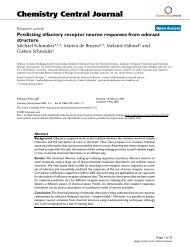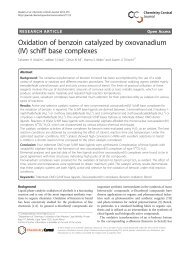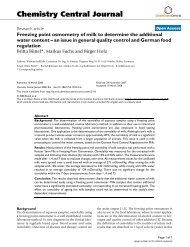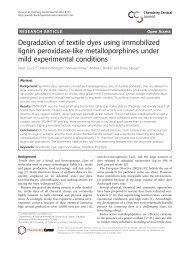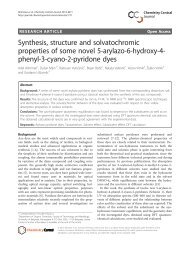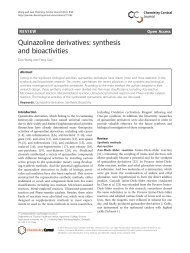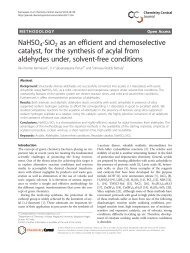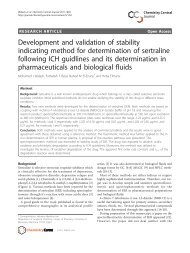Antioxidant activity relationship of phenolic compounds in ...
Antioxidant activity relationship of phenolic compounds in ...
Antioxidant activity relationship of phenolic compounds in ...
Create successful ePaper yourself
Turn your PDF publications into a flip-book with our unique Google optimized e-Paper software.
Orčić et al. Chemistry Central Journal 2011, 5:34<br />
http://journal.chemistrycentral.com/content/5/1/34<br />
RESEARCH ARTICLE<br />
Open Access<br />
<strong>Antioxidant</strong> <strong>activity</strong> <strong>relationship</strong> <strong>of</strong> <strong>phenolic</strong><br />
<strong>compounds</strong> <strong>in</strong> Hypericum perforatum L.<br />
Dejan Z Orčić 1 , Neda M Mimica-Dukić 1* , Mar<strong>in</strong>a M Francišković 1 , Slobodan S Petrović 2 and Emilija Đ Jov<strong>in</strong> 1<br />
Abstract<br />
Background: The St John’s Wort (Hypericum perforatum; Clusiaceae) has been used <strong>in</strong> traditional and modern<br />
medic<strong>in</strong>e for a long time due to its high content <strong>of</strong> biologically active <strong>phenolic</strong>s. The purpose <strong>of</strong> this work was to<br />
develop a method for their fractionation and identification, and to determ<strong>in</strong>e the most active antioxidant<br />
<strong>compounds</strong> <strong>in</strong> plant extract.<br />
Results: An LC-MS method which enables fast qualitative and semiquantitative analysis was developed. The<br />
composition determ<strong>in</strong>ed is <strong>in</strong> agreement with the previous results, where 6 flavonoids, 4 naphthodianthrones and<br />
4 phlorogluc<strong>in</strong>ols have been identified. Significant antioxidant <strong>activity</strong> was determ<strong>in</strong>ed for most <strong>of</strong> the fractions by<br />
DPPH assay (the lowest IC 50 <strong>of</strong> 0.52 μg/ml), NO scaveng<strong>in</strong>g (6.11 μg/ml), superoxide scaveng<strong>in</strong>g (1.86 μg/ml), lipid<br />
peroxidation (0.0079 μg/ml) and FRAP (the highest reduction capacity <strong>of</strong> 104 mg Fe equivalents/g) assays.<br />
Conclusion: LC-MS technique has been successfully applied for a quick separation and identification <strong>of</strong> the major<br />
components <strong>of</strong> H. perforatum fractions. Majority <strong>of</strong> the fractions analyzed have expressed a very high antioxidative<br />
<strong>activity</strong> when compared to synthetic antioxidants. The antioxidant <strong>activity</strong> could be attributed to flavonoids and<br />
<strong>phenolic</strong> acids, while phlorogluc<strong>in</strong>ols and naphthodianthrones showed no significant <strong>activity</strong>. It is demonstrated<br />
that it is possible to obta<strong>in</strong>, by fractionation, H. perforatum preparations with significantly <strong>in</strong>creased phlorogluc<strong>in</strong>olsto-naphthodianthrones<br />
ratio (up to 95:5).<br />
Background<br />
Hypericum perforatum L. (St. John’s wort) is a representative<br />
<strong>of</strong> the Clusiaceae family with confirmed therapeutic<br />
effects on burns, bruises, swell<strong>in</strong>g, anxiety, mild to<br />
moderate depression [1], antidepressant, antiviral,<br />
wound heal<strong>in</strong>g, analgesic, hepatoprotective, antioxidant<br />
and antimicrobial <strong>activity</strong> [2-5]. Hyperfor<strong>in</strong> is believed<br />
to be the major constituent responsible for the antidepressant<br />
<strong>activity</strong>, although discrepancies <strong>in</strong> the doseresponse<br />
<strong>relationship</strong> imply that other constituents are<br />
also <strong>in</strong>volved [6]. Naphthodianthrones, especially hyperic<strong>in</strong>-like<br />
<strong>compounds</strong>, are shown to posses a strong antiviral<br />
effect [7]. Flavonoids are <strong>of</strong> a special <strong>in</strong>terest due<br />
to their antioxidative properties i.e. excellent radical<br />
scaveng<strong>in</strong>g ability [6].<br />
* Correspondence: neda.mimica-dukic@dh.uns.ac.rs<br />
1 Department <strong>of</strong> Chemistry, Biochemistry and Environmental Protection,<br />
University <strong>of</strong> Novi Sad Faculty <strong>of</strong> Sciences, Trg Dositeja Obradovića 3, Novi<br />
Sad, Serbia<br />
Full list <strong>of</strong> author <strong>in</strong>formation is available at the end <strong>of</strong> the article<br />
Reactive oxygen species (ROS) have been implicated <strong>in</strong><br />
pathogenesis <strong>of</strong> many diseases, <strong>in</strong>clud<strong>in</strong>g cancer, mutagenesis,<br />
Alzheimer’s, AIDS, etc. [8]. Many synthetic antioxidants<br />
are currently <strong>in</strong> use; nevertheless, there is a<br />
grow<strong>in</strong>g evidence <strong>of</strong> consumer preference for natural<br />
antioxidants because <strong>of</strong> their potentially lower toxicity.<br />
H. perforatum extracts are already proven to <strong>in</strong>hibit<br />
lipid peroxidation <strong>in</strong> vivo [5].<br />
Previous results [9] demonstrated that H. perforatum<br />
fractions, obta<strong>in</strong>ed by successive liquid-liquid extractions<br />
with solvents <strong>of</strong> different polarities, have different epileptic<br />
activities (rang<strong>in</strong>g from <strong>in</strong>hibitory to stimulatory),<br />
and that this approach can po<strong>in</strong>t out to <strong>compounds</strong><br />
responsible for pharmacological <strong>activity</strong>. In this work<br />
eight fractions <strong>of</strong> H. perforatum, obta<strong>in</strong>ed by an externally<br />
developed method <strong>of</strong> fractionation devised to separate<br />
ma<strong>in</strong> constituents <strong>of</strong> the plant, were exam<strong>in</strong>ed. The<br />
chemical composition <strong>of</strong> all extracts has been analyzed<br />
by rapid-resolution liquid chromatography, as opposed<br />
to the previously used classical high-performance liquid<br />
chromatography [10-18]. <strong>Antioxidant</strong> <strong>activity</strong> has been<br />
© 2011 Orččićć et al
Orčić et al. Chemistry Central Journal 2011, 5:34<br />
http://journal.chemistrycentral.com/content/5/1/34<br />
Page 2 <strong>of</strong> 8<br />
assessed by scaveng<strong>in</strong>g DPPH radical, NO radical, superoxide<br />
anion radical, FRAP test, and lipid peroxidation<br />
us<strong>in</strong>g a l<strong>in</strong>seed oil as a substrate. Where possible, synthetic<br />
antioxidants BHT (3,5-di-tert-butyl-4-hydroxytoluene)<br />
and BHA (2-tert-butyl-4-hydroxyanisole) were<br />
used as standards. An attempt was made to correlate<br />
chemical composition <strong>of</strong> the extracts with its antioxidant<br />
<strong>activity</strong> and determ<strong>in</strong>e which group <strong>of</strong> biomolecules<br />
is the most potent.<br />
Results<br />
LC-MS analysis<br />
LC-MS technique has been successfully applied for a<br />
quick separation and identification <strong>of</strong> the major components<br />
<strong>of</strong> H. perforatum fractions. Detected <strong>compounds</strong><br />
are representatives <strong>of</strong> three groups: flavonoids, naphthodianthrones<br />
and phlorogluc<strong>in</strong>ols.<br />
Peaks identification was done by compar<strong>in</strong>g the mass<br />
spectra and retention times with already published data<br />
[17]. Four naphthodianthrones (protopseudohyperic<strong>in</strong>,<br />
pseudohyperic<strong>in</strong>, protohyperic<strong>in</strong> and hyperic<strong>in</strong>) and four<br />
phlorogluc<strong>in</strong>ols (hyperfir<strong>in</strong>, adhyperfir<strong>in</strong>, hyperfor<strong>in</strong>,<br />
adhyperfor<strong>in</strong>) were identified together with several flavonoids<br />
(hyperoside, rut<strong>in</strong>, quercitr<strong>in</strong> and quercet<strong>in</strong>) and a<br />
small amount <strong>of</strong> caffeoylqu<strong>in</strong>ic acid (Table 1). The<br />
group<strong>in</strong>g <strong>of</strong> <strong>compounds</strong> by classes is observed, with flavonoids<br />
and <strong>phenolic</strong> acids elut<strong>in</strong>g between 0 and 2.5<br />
m<strong>in</strong>, naphthodianthrones <strong>in</strong> 2.5-4.7 m<strong>in</strong>, and phlorogluc<strong>in</strong>ols<br />
<strong>in</strong> 4.7-6.5 m<strong>in</strong> <strong>in</strong>terval (Figure 1). The relative<br />
abundance <strong>of</strong> each group is determ<strong>in</strong>ed by the normalization<br />
method, as an area percent <strong>of</strong> all peaks with similar<br />
spectra elut<strong>in</strong>g with<strong>in</strong> a given retention time range<br />
Table 1 Retention times and [M-H] - ions <strong>of</strong> identified<br />
peaks<br />
Peak<br />
t R<br />
[m<strong>in</strong>]<br />
[M-H] - ,<br />
m/z<br />
Compound<br />
1 0.13 353 caffeoylqu<strong>in</strong>ic acid<br />
463 quercet<strong>in</strong>-3-O-b-D-galactopyranoside<br />
(hyperoside)<br />
609 quercet<strong>in</strong>-3-O-rut<strong>in</strong>oside (rut<strong>in</strong>)<br />
2 0.16 447 quercet<strong>in</strong>-3-O-a-L-rhamnopyranoside<br />
(quercitr<strong>in</strong>)<br />
3 0.34 301 quercet<strong>in</strong><br />
4 0.96 537 I3, II8-biapigen<strong>in</strong><br />
5 1.47 537 ament<strong>of</strong>lavone (I3’, II8-biapigen<strong>in</strong>)<br />
6 2.75 521 protopseudohyperic<strong>in</strong><br />
7 2.87 519 pseudohyperic<strong>in</strong><br />
8 3.69 505 protohyperic<strong>in</strong><br />
9 3.83 503 hyperic<strong>in</strong><br />
10 4.80 467 hyperfir<strong>in</strong><br />
11 4.95 481 adhyperfir<strong>in</strong><br />
12 5.53 535 hyperfor<strong>in</strong><br />
13 5.68 549 adhyperfor<strong>in</strong><br />
Figure 1 LC-MS-MS chromatograms (base peak<br />
chromatograms, BPC) <strong>of</strong> H. perforatum extract fractions: 1.<br />
quercet<strong>in</strong>-3-O-b-D-galactopyranoside (hyperoside) and quercet<strong>in</strong>-3-<br />
O-rut<strong>in</strong>oside (rut<strong>in</strong>), 2. quercet<strong>in</strong>-3-O-a-L-rhamnopyranoside<br />
(quercitr<strong>in</strong>), 3. quercet<strong>in</strong>, 4. biapigen<strong>in</strong>, 5. ament<strong>of</strong>lavone, 6.<br />
protopseudohyperic<strong>in</strong>, 7. pseudohyperic<strong>in</strong>, 8. protohyperic<strong>in</strong>, 9.<br />
hyperic<strong>in</strong>, 10. hyperfir<strong>in</strong>, 11. adhyperfir<strong>in</strong>, 12. hyperfor<strong>in</strong>, 13.<br />
adhyperfor<strong>in</strong><br />
(Table 2). It is important to note that area percents,<br />
although useful for the comparison <strong>of</strong> the fractions’ purity,<br />
neither directly correspond to the percentage composition<br />
<strong>in</strong> weight or amount, nor account for the total<br />
content <strong>of</strong> the <strong>compounds</strong>. S<strong>in</strong>ce there were no reference<br />
standards available, total peak areas (divided by the<br />
<strong>in</strong>jected mass <strong>of</strong> extract) were used as a measure <strong>of</strong> the<br />
absolute content <strong>of</strong> the separate compound classes.<br />
<strong>Antioxidant</strong> <strong>activity</strong><br />
All fractions were subjected to the antioxidant <strong>activity</strong><br />
assays, with results given <strong>in</strong> Table 3. Activities varied<br />
widely, from very high to moderate. All samples demonstrated<br />
ability to scavenge DPPH radicals, where most <strong>of</strong><br />
them had IC 50 value lower than the synthetic antioxidants<br />
BHT and BHA, except the fraction I/4. Superoxide<br />
anion scaveng<strong>in</strong>g was also observed, with IC 50 values<br />
<strong>in</strong> range 1.86-32.4 μg/mL (the most active be<strong>in</strong>g I/2 and<br />
the least active I/5). Under the same experimental conditions,<br />
synthetic antioxidants BHT and BHA did not<br />
reach 50% <strong>in</strong>hibition due to their low solubility <strong>in</strong> the<br />
reaction medium (water). Inhibition <strong>of</strong> lipid peroxidation<br />
by extract fractions was also demonstrated, with<br />
IC 50 higher (i.e. lower <strong>activity</strong>) than the synthetic antioxidants.<br />
Most <strong>of</strong> the fractions have shown scavenger<br />
<strong>activity</strong> <strong>in</strong> neutraliz<strong>in</strong>g NO radical. For fractions I/2 and
Orčić et al. Chemistry Central Journal 2011, 5:34<br />
http://journal.chemistrycentral.com/content/5/1/34<br />
Page 3 <strong>of</strong> 8<br />
Table 2 Relative abundances a <strong>of</strong> compound classes <strong>in</strong> analyzed fractions<br />
Peaks<br />
0-2.5 m<strong>in</strong><br />
Peaks<br />
2.5-4.7 m<strong>in</strong> c Peaks<br />
4.7-6.5 m<strong>in</strong> d<br />
Total b Phenolic acids Flavonoid glycosides Flavonoid aglycones Biflavonoids<br />
I-1 16.2 0.430 2.72 4.41 6.14 31.8 68.7<br />
I-2 37.2 1.30 6.49 20.3 3.02 49.1 nd<br />
I-3 29.9 nd e 0.414 8.49 12.7 94.1 610<br />
I-4 0.584 nd nd nd nd 137 968<br />
I-5 420 nd nd 11.7 263 1000 nd<br />
II-2p 17.9 0.866 5.77 7.67 0.496 36.9 nd<br />
II-2s 17.3 0.743 5.83 6.70 1.40 41.5 nd<br />
II-3 31.4 0.257 4.50 7.75 14.2 119 28.4<br />
a given as peak areas divided by <strong>in</strong>jected mass, normalized to 1000 for convenience<br />
b <strong>in</strong>clud<strong>in</strong>g <strong>phenolic</strong> acids, flavonoids, biflavonoids and unidentified peaks<br />
c mostly naphthodianthrones<br />
d phlorogluc<strong>in</strong>ols<br />
e not detected<br />
I/4 it was not possible to determ<strong>in</strong>e IC 50 values because<br />
neutralization <strong>of</strong> 50% NO radicals was not accomplished<br />
even with the highest concentrations <strong>of</strong> 22 μg/mL and<br />
120 μg/mL, respectively. Under the experimental conditions,<br />
synthetic antioxidants BHT and BHA did not<br />
reach 50% <strong>in</strong>hibition due to their low solubility <strong>in</strong> water.<br />
Discussion<br />
It has already been demonstrated [10,17,19] that Hypericum<br />
perforatum extracts conta<strong>in</strong> several classes <strong>of</strong> plant<br />
<strong>phenolic</strong>s with a documented biological <strong>activity</strong>, <strong>in</strong>clud<strong>in</strong>g<br />
antidepressant phlorogluc<strong>in</strong>ols (hyperfor<strong>in</strong> and its derivative<br />
adhyperfor<strong>in</strong>), antiviral, antibacterial and photosensitiz<strong>in</strong>g<br />
naphthodianthrones (hyperic<strong>in</strong> and pseudohyperic<strong>in</strong>,<br />
as well as their precursors - protohyperic<strong>in</strong> and protopseudohyperic<strong>in</strong>),<br />
antioxidant flavonoids (mostly quercet<strong>in</strong> and<br />
kaempferol glycosides and aglycones, as well as biflavonoids),<br />
and <strong>phenolic</strong> acids (mostly isomeric caffeoylqu<strong>in</strong>ic<br />
acids). For the purpose <strong>of</strong> pharmaceutical products<br />
production, the preparation <strong>of</strong> the enriched extracts may<br />
be <strong>of</strong> <strong>in</strong>terest. In this paper, it has been demonstrated that<br />
it is possible to obta<strong>in</strong> extracts with high levels <strong>of</strong> phlorogluc<strong>in</strong>ols<br />
(I/4) and naphthodianthrones (I/5) by us<strong>in</strong>g a<br />
relatively simple procedure.<br />
The antioxidant <strong>activity</strong> <strong>of</strong> H. perforatum extracts is<br />
well known [4,20] and is to be expected due to a high<br />
content <strong>of</strong> <strong>phenolic</strong> <strong>compounds</strong>. Although several publications<br />
were focused on this topic [21,22], there is still a<br />
lack <strong>of</strong> conclusive evidence to determ<strong>in</strong>e which <strong>phenolic</strong>s<br />
class is the most responsible for the antioxidant<br />
<strong>activity</strong> <strong>of</strong> Hypericum plants. S<strong>in</strong>ce the procedure<br />
described <strong>in</strong> this paper enabled the isolation <strong>of</strong> extract<br />
fractions enriched <strong>in</strong> different groups <strong>of</strong> <strong>phenolic</strong>s, it<br />
was possible to establish the correlation between the<br />
extract composition and <strong>activity</strong>, and to dist<strong>in</strong>guish<br />
structural features most important for scaveng<strong>in</strong>g and<br />
antioxidant properties. In addition, synergistic action <strong>of</strong><br />
certa<strong>in</strong> <strong>compounds</strong> is also to be expected.<br />
Table 3 Results <strong>of</strong> antioxidant <strong>activity</strong> assays<br />
DPPH SO LP NO FRAP<br />
Fractions IC 50 [μg/mL] [μg/umol] a IC 50 [μg/mL] IC 50 [μg/mL] IC 50 [μg/mL] [mg Fe/g] b<br />
I/1 1.55 69.2 11.1 2.25 32.8 80.0<br />
I/2 1.09 48.7 1.86 7.92 > > 22 104.0<br />
I/3 6.66 297 11.7 17.8 53.7 10.0<br />
I/4 32.8 1464 20.6 2.33 > 120 7.00<br />
I/5 11.0 491 32.4 8.09 53.7 12.0<br />
II/2s 0.520 23.2 7.10 7.00 83.9 25.0<br />
II/2p 1.16 51.8 5.70 12.2 30.2 44.0<br />
II/3 2.61 117 8.80 8.31 6.11 17.0<br />
BHT 8.28 369 n/a c 0.859 n/a 25.3<br />
BHA 12.4 553 n/a 0.138 n/a n/a<br />
a mass <strong>of</strong> extract (<strong>in</strong> μg) needed for 50% neutralization <strong>of</strong> 1 μmol <strong>of</strong> DPPH<br />
b mass <strong>of</strong> Fe 3+ that can be reduced by 1 g <strong>of</strong> H. perforatum fraction.<br />
c 50% <strong>in</strong>hibition not reached
Orčić et al. Chemistry Central Journal 2011, 5:34<br />
http://journal.chemistrycentral.com/content/5/1/34<br />
Page 4 <strong>of</strong> 8<br />
S<strong>in</strong>ce it is now recognized that there is no s<strong>in</strong>gle test<br />
to evaluate antioxidant activities <strong>of</strong> the <strong>compounds</strong> with<br />
wide spectra <strong>of</strong> structures, modes <strong>of</strong> action, and physical<br />
and chemical properties [23], several different assays<br />
were employed as a part <strong>of</strong> our <strong>in</strong>vestigation.<br />
DPPH (2,2-diphenyl-1-picrylhydrazyl) is a stable radical<br />
and is <strong>of</strong>ten used <strong>in</strong> assessment <strong>of</strong> the antioxidant<br />
<strong>activity</strong>. The free radical DPPH possesses a characteristic<br />
absorption at 517 nm (purple <strong>in</strong> color), which decreases<br />
significantly when exposed to radical-scavengers (due to<br />
hydrogen atoms transfer from antioxidant to DPPH). A<br />
lower absorbance at 517 nm <strong>in</strong>dicates a higher radicalscaveng<strong>in</strong>g<br />
<strong>activity</strong> <strong>of</strong> extract [24]. In this assay, the ability<br />
<strong>of</strong> the <strong>in</strong>vestigated H. perforatum fractions to act as<br />
donors <strong>of</strong> hydrogen atoms or electrons <strong>in</strong> transformation<br />
<strong>of</strong> DPPH radical <strong>in</strong>to its reduced form DPPH-H<br />
was <strong>in</strong>vestigated.<br />
The <strong>activity</strong> observed is <strong>in</strong> a very good correlation<br />
with the composition, where the most active fractions<br />
are those rich <strong>in</strong> flavonoid glycosides (followed by m<strong>in</strong>ute<br />
amounts <strong>of</strong> <strong>phenolic</strong> acids) and poor <strong>in</strong> biflavonoids<br />
(ament<strong>of</strong>lavone,biapigen<strong>in</strong>):I/2,II/2pandII/2s.As<br />
opposed to this, fractions with high biflavonoids level<br />
and low flavonoid glycosides content (I/3, I/5) exhibited<br />
significantly lower <strong>activity</strong> (i.e. higher IC 50 values), and<br />
fraction I-4, practically devoid <strong>of</strong> flavonoids and <strong>phenolic</strong><br />
acids, was the least active. It is notable that only flavonoid<br />
glycosides (with quercet<strong>in</strong>-3-O-rut<strong>in</strong>oside,<br />
galactoside and rhamnoside as the most abundant) seem<br />
to contribute significantly to radical-scaveng<strong>in</strong>g <strong>activity</strong><br />
(given as 1/IC 50 ), with Pearson’s correlation coefficient r<br />
= 0.778 (0.922 if the outlier - II/2p - is excluded),<br />
together with <strong>phenolic</strong> acids (r = 0.769, or 0.929 without<br />
II/2p). These observations are only partially <strong>in</strong> agreement<br />
with the previous results [21]. While it would be<br />
expected for flavonoid aglycones to be more active than<br />
their 3-O-glycosides [23], no correlation was found<br />
between aglycones content and antioxidant <strong>activity</strong> as<br />
determ<strong>in</strong>ed by DPPH test, and the <strong>activity</strong> <strong>of</strong> fractions<br />
I/3 and I/5 (rich <strong>in</strong> flavonoid and biflavonoid aglycones,<br />
poor <strong>in</strong> glycosides and <strong>phenolic</strong> acids) is low.<br />
At the same time, no correlation was found between<br />
<strong>activity</strong> and content <strong>of</strong> naphthodianthrones and phlorogluc<strong>in</strong>ols,<br />
which is <strong>in</strong> accordance with the results <strong>of</strong><br />
Silva et al. [23]. The low <strong>activity</strong> <strong>of</strong> biflavonoids present<br />
<strong>in</strong> Hypericum perforatum extracts was already documented<br />
[22] and is to be expected. These <strong>compounds</strong>, be<strong>in</strong>g<br />
dimers <strong>of</strong> apigen<strong>in</strong>, possess only 4’-hydroxyl on B-r<strong>in</strong>g,<br />
while it is known that for maximum <strong>activity</strong> a catechol<br />
structure (3’,4’-dihydroxylated benzene moiety), as present<br />
<strong>in</strong> quercet<strong>in</strong>, is required [21-23,25].<br />
FRAP test is based on nonspecific reduction <strong>of</strong> Fe 3<br />
+ -TPTZ <strong>in</strong>to the blue Fe 2+ -TPTZ by the extract, which<br />
leads to an <strong>in</strong>creased absorbance at 593 nm. Results are<br />
presented as mg <strong>of</strong> Fe 2+ /1 g <strong>of</strong> dried fraction and represent<br />
the mass <strong>of</strong> Fe 3+ that can be reduced by 1 g <strong>of</strong> H.<br />
perforatum fraction. Several important facts should be<br />
kept <strong>in</strong> m<strong>in</strong>d when <strong>in</strong>terpret<strong>in</strong>g results <strong>of</strong> the test. First,<br />
it measures ability <strong>of</strong> a sample to participate <strong>in</strong> one-electron<br />
redox reactions, mean<strong>in</strong>g that antioxidants with different<br />
mode <strong>of</strong> action (e.g. carotenoids, behav<strong>in</strong>g as<br />
radical scavengers) will not be ignored. Second, only<br />
water-soluble antioxidants will react s<strong>in</strong>ce the assay is<br />
performed <strong>in</strong> aqueous solution. Third, the reduction<br />
capacity determ<strong>in</strong>ed <strong>in</strong> the absence <strong>of</strong> biomolecules as<br />
substrates does not necessarily reflect the antioxidant<br />
<strong>activity</strong> i.e. protective capabilities. Still, it can be a relevant<br />
factor <strong>in</strong> detoxification <strong>of</strong> reactive species such as<br />
HOCl and ONOO - [26].<br />
FRAP test has shown that H. perforatum fractions<br />
have the significant reduction potential, with fractions I/<br />
1, I/2 and II/2p be<strong>in</strong>g more active than the synthetic<br />
antioxidant BHT. Tak<strong>in</strong>g <strong>in</strong>to account the results <strong>of</strong><br />
HPLC analysis, reduction capacity may be attributed<br />
mostly to the content <strong>of</strong> <strong>phenolic</strong> acids and flavonoid<br />
glycosides (although Pearson’s correlation coefficients<br />
are quite low, 0.768 and 0.584, respectively). The contribution<br />
<strong>of</strong> phlorogluc<strong>in</strong>ols to the total reduction capacity<br />
is negligible - two fractions rich <strong>in</strong> these <strong>compounds</strong>, I/<br />
4 and I/3, exhibited the lowest capacity <strong>of</strong> all the samples<br />
exam<strong>in</strong>ed. Their <strong>in</strong><strong>activity</strong> can be expla<strong>in</strong>ed by the<br />
lack <strong>of</strong> easily oxidizable functional groups (such as <strong>phenolic</strong><br />
moiety). The low <strong>activity</strong> is also observed for<br />
naphthodianthrones and biflavonoids, fractions with<br />
especially high content <strong>of</strong> these <strong>compounds</strong> (I/3, II/3, I/<br />
4, I/5) hav<strong>in</strong>g the lowest reduction capacity.<br />
In superoxide anion test the ability <strong>of</strong> H. perforatum<br />
fractions to neutralize superoxide anion radical (O 2 - )<br />
was evaluated. While superoxide is <strong>in</strong>tentionally producedbysomecells(phagocytes)<br />
<strong>in</strong> order to combat<br />
<strong>in</strong>fection, its presence is usually deleterious to organism,<br />
lead<strong>in</strong>g (if not degraded by superoxide dismutase) to<br />
degenerative processes and death. In the employed<br />
assay, O 2 - anion was generated <strong>in</strong> situ, by electrontransfer<br />
from NADH to O 2 present <strong>in</strong> solution (a process<br />
analogous to NADPH oxidase- and NADH dehydrogenase-catalyzed<br />
generation <strong>in</strong> vivo) [20].<br />
All <strong>in</strong>vestigated extract fractions exhibited dosedependent<br />
O 2 - scaveng<strong>in</strong>g <strong>activity</strong>. The weakest <strong>activity</strong><br />
was aga<strong>in</strong> observed <strong>in</strong> samples rich <strong>in</strong> biflavonoids,<br />
naphthodianthrones and phlorogluc<strong>in</strong>ols but with low<br />
levels <strong>of</strong> other <strong>phenolic</strong>s - I/4 and I/5. A high degree <strong>of</strong><br />
correlation was found between the <strong>activity</strong> (expressed as<br />
1/IC 50 ) and the content <strong>of</strong> <strong>phenolic</strong> acids (r = 0.857),<br />
flavonoid aglycones (r = 0.791, without the outlier I/5: r<br />
= 0.926), and sum <strong>of</strong> <strong>phenolic</strong> acids, flavonoid aglycones<br />
and glycosides (r = 0.883, or 0.921 without fraction I/5).<br />
These observations are <strong>in</strong> agreement with the empirical
Orčić et al. Chemistry Central Journal 2011, 5:34<br />
http://journal.chemistrycentral.com/content/5/1/34<br />
Page 5 <strong>of</strong> 8<br />
rule that a catechol moiety (present both <strong>in</strong> quercet<strong>in</strong><br />
and <strong>in</strong> caffeoylqu<strong>in</strong>ic acid) is required for a maximum<br />
radical-scaveng<strong>in</strong>g <strong>activity</strong> [21-23,25].<br />
One <strong>of</strong> the ma<strong>in</strong> detrimental effects <strong>of</strong> reactive radical<br />
species (especially OH·) is lipid peroxidation (LP) i.e.<br />
oxidative degradation <strong>of</strong> lipids, lead<strong>in</strong>g to biological<br />
membranes damage and, possibly, to cell death or formation<br />
<strong>of</strong> mutagenic/carc<strong>in</strong>ogenic products. The best<br />
known LP product is malondialdehyde (MDA) and it<br />
has been used most widely as a biomarker <strong>in</strong> various<br />
studies associated with lipid peroxidation. Determ<strong>in</strong>ation<br />
<strong>of</strong> MDA may be problematic because <strong>of</strong> its high re<strong>activity</strong><br />
and water solubility, and it is therefore necessary to<br />
generate stable derivatives. One <strong>of</strong> the most commonly<br />
used is thiobarbituric acid adduct, which can be determ<strong>in</strong>ed<br />
us<strong>in</strong>g spectrophotometry. In our research, l<strong>in</strong>seed<br />
oil was used as a substrate for LP due to its high content<br />
<strong>of</strong> polyunsaturated fatty acids. LP <strong>of</strong> polyunsaturated<br />
fatty acids was triggered by Fe 2+ and ascorbate<br />
(which, through Fenton reaction, generate OH· radicals)<br />
[27].<br />
All samples were able to <strong>in</strong>hibit lipid peroxidation <strong>in</strong> a<br />
dose-dependent manner, although not as efficient as<br />
synthetic antioxidants BHT and BHA. It is notable that<br />
fraction I/4, by far the poorest <strong>in</strong> flavonoids and <strong>phenolic</strong><br />
acids and one <strong>of</strong> the least active <strong>in</strong> DPPH, FRAP,<br />
superoxide scaveng<strong>in</strong>g and NO scaveng<strong>in</strong>g assays, exhibited<br />
very strong LP-<strong>in</strong>hibit<strong>in</strong>g <strong>activity</strong>, matched only by<br />
I/1. On the other hand, fraction II/2p, among the most<br />
active <strong>in</strong> mentioned assays, was second-to-weakest <strong>in</strong><br />
this assay. It was not possible to correlate the test<br />
results with chemical composition <strong>of</strong> fractions. These<br />
results are <strong>in</strong> disagreement with those <strong>of</strong> Silva et al.<br />
[21], which implied flavonoids as ma<strong>in</strong> anti-LP constituents<br />
<strong>of</strong> Hypericum perforatum extracts.<br />
It should be noted that the effects <strong>of</strong> plant <strong>phenolic</strong>s<br />
on Fe 2+ /ascorbate-<strong>in</strong>duced lipid peroxidation are complex.<br />
It is known that flavonoids, especially those with<br />
catechol-like substitution on B r<strong>in</strong>g and either 4-oxo-3-<br />
hydroxy or 4-oxo-5-xydroxy, are efficient <strong>in</strong> <strong>in</strong>hibit<strong>in</strong>g<br />
LP, both through radical scaveng<strong>in</strong>g and through chelation<br />
<strong>of</strong> iron ions. On the other hand, <strong>in</strong> the presence <strong>of</strong><br />
transition metal ions, flavonoids also exhibit pro-oxidant<br />
effect [27], cont<strong>in</strong>uously reduc<strong>in</strong>g these ions and thus<br />
enabl<strong>in</strong>g them to generate OH· via Fenton reaction.<br />
Biflavonoids, while be<strong>in</strong>g very poor radical scavengers,<br />
are proven to <strong>in</strong>hibit LP with similar potency as flavonoid<br />
glycosides, probably through iron chelation [22],<br />
while naphthodianthrones and phlorogluc<strong>in</strong>ols are not<br />
active [21].<br />
F<strong>in</strong>ally, nitric oxide scaveng<strong>in</strong>g ability was also assayed<br />
for all fractions. While NO is normally produced <strong>in</strong><br />
organism as a messenger and as a part <strong>of</strong> immune<br />
response, its reaction with O 2 - produces highly reactive<br />
peroxynitrite that can damage various biomolecules.<br />
Thus, the ability <strong>of</strong> extracts to neutralize NO and<br />
ONOO - can have beneficial effects.<br />
While all <strong>in</strong>vestigated extract fractions demonstrated<br />
dose-dependent scaveng<strong>in</strong>g <strong>of</strong> NO, for most <strong>of</strong> them<br />
IC 50 values were high (or, <strong>in</strong> the case <strong>of</strong> I/2 and I/4,<br />
50% neutralization was not accomplished with<strong>in</strong> the<br />
exam<strong>in</strong>ed concentration range). As with lipid peroxidation<br />
assay, it was not possible to attribute the NO<br />
scaveng<strong>in</strong>g <strong>activity</strong> to any particular class <strong>of</strong> <strong>phenolic</strong>s.<br />
Conclusion<br />
In conclusion, by us<strong>in</strong>g fractionation comb<strong>in</strong>ed with<br />
assays and LC-MS analysis, it was possible to identify<br />
compound classes responsible for H. perforatum antioxidant<br />
<strong>activity</strong>. It was demonstrated that it can mostly be<br />
attributed to flavonoid glycosides and <strong>phenolic</strong> acids<br />
(chlorogenic acid), while phlorogluc<strong>in</strong>ols (lack<strong>in</strong>g poly<strong>phenolic</strong><br />
structure), biflavonoids (lack<strong>in</strong>g catechol moiety)<br />
and naphthodianthrones showed no significant<br />
<strong>activity</strong>.<br />
Experimental<br />
Chemicals<br />
Follow<strong>in</strong>g reagents were purchased from Sigma-Aldrich<br />
Chem, Ste<strong>in</strong>heim, Germany: BHT, BHA, NADH, phenaz<strong>in</strong>e<br />
methosulfate (PMS). Sulfanilamide, 2,2-diphenyl-1-<br />
picrylhydrazyl (DPPH), and 2-thiobarbituric acid (TBA)<br />
were obta<strong>in</strong>ed from Fluka Chemie GmbH (Buchs, Switzerland).<br />
Trichloroacetic acid was purchased from Lach-<br />
Ner (Neratovice, Czech Republic), nitroblue tetrazolium<br />
(NBT) from Alfa Aesar (Karlsruhe, Germany), and<br />
sodium nitroprusside (SNP) from Reanal (Budapest,<br />
Hungary). N-(1-naphthyl) ethylenediam<strong>in</strong>e dihydrochloride<br />
(NEDA), ascorbic acid, 2,4,6-tripyridil-s-triaz<strong>in</strong>e<br />
(TPTZ), and formic acid was acquired from Merck,<br />
Darmstadt, Germany. Tween-80 and gradient-grade<br />
acetonitrile were obta<strong>in</strong>ed from J. T. Baker (Deventer,<br />
Netherlands). L<strong>in</strong>seed oil is prepared by solvent extraction<br />
<strong>of</strong> l<strong>in</strong>seed, and fatty acids composition is determ<strong>in</strong>ed<br />
by GC-MS to be: l<strong>in</strong>olenic 69.7%, l<strong>in</strong>oleic 13.5%,<br />
stearic 9.4% and palmitic 7.4%. FRAP reagent was made<br />
by mix<strong>in</strong>g 50 ml <strong>of</strong> acetate buffer (0.3 mol/L, pH = 3.6),<br />
5mL<strong>of</strong>FeCl 3·6H 2 O(20mmol/L)and5mL<strong>of</strong>TPTZ<br />
solution (10 mol/L <strong>in</strong> 40 mmol/L HCl). TBA reagent<br />
was prepared by dissolv<strong>in</strong>g 3 g <strong>of</strong> TBA, 120 g <strong>of</strong> trichloroacetic<br />
acid and 10.4 mL <strong>of</strong> perchloric acid <strong>in</strong><br />
water and fill<strong>in</strong>g up to 1 L. All chemicals were reagent<br />
grade, unless otherwise stated.<br />
Plant material<br />
Hypericum perforatum L. (Clusiaceae) samples were collectedmidJuly2007fromthemounta<strong>in</strong>Čemernik,<br />
south <strong>of</strong> Serbia, at bloom<strong>in</strong>g stage. The voucher
Orčić et al. Chemistry Central Journal 2011, 5:34<br />
http://journal.chemistrycentral.com/content/5/1/34<br />
Page 6 <strong>of</strong> 8<br />
specimen (No. 11340) is deposited at the Herbarium <strong>of</strong><br />
the Institute <strong>of</strong> Botany and Botanical Garden “Jevremovac”,<br />
Faculty <strong>of</strong> Biology, University <strong>of</strong> Belgrade (BEOU).<br />
Topflower<strong>in</strong>gpartswereusedforextractpreparation<br />
(80% flowers and 20% rest <strong>of</strong> the plant). Plant material<br />
was dried and powdered, and dried aga<strong>in</strong> at 105°C by<br />
steam heat<strong>in</strong>g.<br />
Extraction<br />
The extraction and fractionation were performed us<strong>in</strong>g<br />
third party-developed procedure (patent pend<strong>in</strong>g).<br />
Dried and powdered plant material was depigmentated<br />
us<strong>in</strong>g chlor<strong>of</strong>orm extraction for 96 h and, after<br />
vacuum-dry<strong>in</strong>g, extracted for 72 h with eight-fold<br />
amount <strong>of</strong> methanol. Both extractions were carried out<br />
at temperatures near the boil<strong>in</strong>g po<strong>in</strong>ts <strong>of</strong> the respective<br />
solvents. The process yielded 6-7% <strong>of</strong> raw extract<br />
on dry weight basis. After removal <strong>of</strong> carotenoids by<br />
petroleum ether extraction and glycosides by ethyl<br />
acetate/water partition<strong>in</strong>g, the residue was fractionated<br />
us<strong>in</strong>g Sephadex LH-20 column to give five fractions<br />
(based on colour and UV/VIS absorption spectra),<br />
labelled I/1 to I/5 for the first batch <strong>of</strong> plant material,<br />
and II/1 to II/5 for the second batch (<strong>of</strong> which, only<br />
sub-fractions II/2s and II/2p, and fraction II/3 were<br />
analyzed).<br />
For the purpose <strong>of</strong> LC analysis and antioxidant assays,<br />
all fractions were dissolved <strong>in</strong> methanol (except fraction<br />
I/4, for which iso-propanol was used, due to low solubility<br />
<strong>in</strong> methanol).<br />
LC-MS analysis<br />
Chemical composition <strong>of</strong> fractions was determ<strong>in</strong>ed by<br />
rapid resolution liquid chromatography with mass selective<br />
detection, us<strong>in</strong>g Agilent Technologies 1200 Series<br />
liquid chromatograph coupled with Agilent Technologies<br />
6410B Series triple-quad (QQQ) mass spectrometer.<br />
Components were separated us<strong>in</strong>g reversed-phase ZorbaxSB-C1830mm×2.1mm×3.5μm<br />
column(Agilent<br />
Technologies), held at 50°C. The mobile phase was<br />
delivered <strong>in</strong> gradient mode (0 m<strong>in</strong> 25% B, 6 m<strong>in</strong> 100%<br />
B, 8 m<strong>in</strong> 100% B, solvent A be<strong>in</strong>g 0.1% aqueous formic<br />
acid with 10 mmol/L CH 3 COONH 4 ,andsolventB<br />
be<strong>in</strong>g acetonitrile), with flow rate <strong>of</strong> 1 mL/m<strong>in</strong>. Injection<br />
volume was 1 μL, except for sample I/5, for which 0.1<br />
μL was used to improve peak shape. Eluted components<br />
were ionized by electrospray ion source (ESI), us<strong>in</strong>g N 2<br />
for nebulization (pressure <strong>of</strong> 35 psi) and dry<strong>in</strong>g (flow <strong>of</strong><br />
9 L/m<strong>in</strong>, temperature <strong>of</strong> 350°C). Capillary voltage was<br />
4000 V and fragmentor voltage 80 V. To <strong>in</strong>crease the<br />
sensitivity, lower the noise, and simplify the spectra,<br />
negative ionization was used. Generated [M-H] - ions<br />
were analyzed us<strong>in</strong>g MS2Scan mode, <strong>in</strong> m/z range 200-<br />
800 Da.<br />
DPPH assay<br />
Selected concentrations (rang<strong>in</strong>g 0.001-12 mg/mL) <strong>of</strong> H.<br />
perforatum fractions (10 μL) were mixed with 190 μL <strong>of</strong><br />
methanol and 100 μL <strong>of</strong> methanolic solution conta<strong>in</strong><strong>in</strong>g<br />
DPPH radicals (67.2 μmol/L). Absorption at 515 nm<br />
was measured by the microplate reader (Multiskan<br />
Spectrum, Thermo Corporation) after 60 m<strong>in</strong> <strong>of</strong> <strong>in</strong>cubation<br />
at room temperature. The radical-scaveng<strong>in</strong>g capacity<br />
(RSC) was calculated us<strong>in</strong>g the equation:<br />
RSC =100− (A average − A corr )<br />
A control<br />
· 100<br />
where A average is absorbance <strong>of</strong> probe, at a given sample<br />
concentration level (average <strong>of</strong> three probes); A corr is<br />
the correction or the absorbance <strong>of</strong> the extract alone<br />
(without reagents), and A control is the absorbance <strong>of</strong> the<br />
reagent (DPPH radical) without the extract. The extract<br />
concentration <strong>in</strong> reaction mixture, result<strong>in</strong>g <strong>in</strong> 50% <strong>in</strong>hibition<br />
<strong>of</strong> DPPH radicals (IC 50 ), was calculated from the<br />
RSC vs. extract concentration curve.<br />
FRAP (ferric reduc<strong>in</strong>g ability <strong>of</strong> plasma)<br />
Selected concentrations (rang<strong>in</strong>g 0.001-12 mg/mL) <strong>of</strong> H.<br />
perforatum fractions (10 μL) were treated with 300 μL<br />
<strong>of</strong> FRAP reagent <strong>in</strong> triplicate. Correction (absorbance <strong>of</strong><br />
the untreated extract) and control (absorbance <strong>of</strong> the<br />
FRAP reagent) were also measured. After 6 m<strong>in</strong> <strong>of</strong> <strong>in</strong>cubation,<br />
the absorbance was measured at 593 nm by the<br />
microplate reader (Multiskan Spectrum, Thermo Corporation).<br />
The calibration curve was constructed us<strong>in</strong>g<br />
the aqueous solution <strong>of</strong> Fe 2+ <strong>in</strong> series <strong>of</strong> concentration<br />
rang<strong>in</strong>g 50-1000 μmol/L. The results were given as mg<br />
<strong>of</strong> Fe 2+ per gram <strong>of</strong> dry extract.<br />
Superoxide anion test<br />
Selected concentrations (rang<strong>in</strong>g 0.001-12 mg/mL) <strong>of</strong> H.<br />
perforatum fractions (10 μL) were mixed with 40 μL <strong>of</strong><br />
144 μmol/L NBT, 20 μL <strong>of</strong> 677 μmol/L NADH, 20 μL<br />
<strong>of</strong> 60 μmol/L PMS and 220 μL <strong>of</strong> pH 8.3 buffer <strong>in</strong> triplicate.<br />
Correction (absorbance <strong>of</strong> untreated extract) and<br />
control (absorbance <strong>of</strong> reagents without extract) were<br />
also measured. After 5 m<strong>in</strong> <strong>of</strong> <strong>in</strong>cubation absorbance<br />
was measured at 560 nm by the microplate reader (Multiskan<br />
Spectrum, Thermo Corporation). The values <strong>of</strong><br />
RSC and IC 50 were calculated <strong>in</strong> the same manner as <strong>in</strong><br />
DPPH test.<br />
Inhibition <strong>of</strong> NO radical<br />
Selected concentrations (rang<strong>in</strong>g 0.001-12 mg/mL) <strong>of</strong> H.<br />
perforatum fractions (10 μL) were mixed with 75 μL <strong>of</strong><br />
SNP and 75 μL <strong>of</strong> phosphate buffer (0.067 mol/L, pH =<br />
7.4) <strong>in</strong> triplicate. Correction (absorbance <strong>of</strong> untreated<br />
extract) and control (absorbance <strong>of</strong> reagents without
Orčić et al. Chemistry Central Journal 2011, 5:34<br />
http://journal.chemistrycentral.com/content/5/1/34<br />
Page 7 <strong>of</strong> 8<br />
extract) were also measured. Samples were <strong>in</strong>cubated<br />
under a fluorescent lamp for 1 h. After the <strong>in</strong>cubation,<br />
<strong>in</strong> each well 150 μL <strong>of</strong> Griess reagent was added and<br />
the absorbance was measured at 546 nm by microplate<br />
reader (Multiskan Spectrum, Thermo Corporation). The<br />
values <strong>of</strong> RSC and IC 50 were calculated <strong>in</strong> the same<br />
manner as <strong>in</strong> DPPH test.<br />
Lipid peroxidation<br />
As a substrate for lipid peroxidation, l<strong>in</strong>seed oil (prepared<br />
<strong>in</strong>-laboratory by hexane extraction <strong>of</strong> l<strong>in</strong>seed)<br />
was emulsified <strong>in</strong> phosphate buffer (0.035% v/v solution)<br />
with addition <strong>of</strong> Tween-80 (0.25% v/v solution)<br />
as an emulsifier. Selected concentrations (rang<strong>in</strong>g<br />
0.0001-1.2 mg/mL) <strong>of</strong> H. perforatum fractions (10 μL),<br />
each <strong>in</strong> triplicate, were mixed with 20 μL <strong>of</strong> 1.875<br />
mmol/L FeSO 4 and 20 μL <strong>of</strong> ascorbate (15.4 μg/mL).<br />
The control and corrections were also made as previously<br />
def<strong>in</strong>ed. All probes were <strong>in</strong>cubated at 37°C for<br />
1 h, after which 200 μL <strong>of</strong> 0.1 mol/L EDTA was added<br />
to b<strong>in</strong>d the Fe 2+ , thus stopp<strong>in</strong>g the reaction. TBA<br />
reagent (2 mL) was added, and the mixture was heated<br />
<strong>in</strong> boil<strong>in</strong>g water bath for 15 m<strong>in</strong> to form a stable,<br />
colored derivative with MDA [28].<br />
After that, probes were centrifuged for 15 m<strong>in</strong> at 3700<br />
rpm and the absorbance was measured at 532 nm. The<br />
values <strong>of</strong> RSC and IC 50 were calculated <strong>in</strong> the same<br />
manner as <strong>in</strong> DPPH test.<br />
Abbreviations<br />
BHT: 3,5-di-tert-butyl-4-hydroxytoluene; BHA: 2-tert-butyl-4-hydroxyanisole;<br />
DPPH: 2,2-diphenyl-1-picrylhydrazyl; ESI: electrospray ionization; NBT:<br />
nitroblue tetrazolium; NEDA: N-(1-naphthyl) ethylenediam<strong>in</strong>e dihydrochloride;<br />
PMS: phenaz<strong>in</strong>e methosulfate; SNP: sodium nitroprusside; TBA: 2-<br />
thiobarbituric acid; TPTZ: 2,4,6-tripyridil-s-triaz<strong>in</strong>e.<br />
Acknowledgements<br />
This research is funded by Serbian M<strong>in</strong>istry <strong>of</strong> Science and Technological<br />
Development research grant Nr. 172058. and Prov<strong>in</strong>cial Secretariat for<br />
Sciences and Technological Development (grants 2011-2014).<br />
Author details<br />
1 Department <strong>of</strong> Chemistry, Biochemistry and Environmental Protection,<br />
University <strong>of</strong> Novi Sad Faculty <strong>of</strong> Sciences, Trg Dositeja Obradovića 3, Novi<br />
Sad, Serbia.<br />
2 BIOSS, Bulevar Oslobođenja 401i, Belgrade, Serbia.<br />
Authors’ contributions<br />
SSP performed sample preparations and fractionation <strong>of</strong> plant material. DZO<br />
developed LC/MS method, performed qualitative <strong>phenolic</strong>s analysis, and<br />
contributed to the results <strong>in</strong>terpretation. MMF and EĐJ performed<br />
antioxidant assays. NMMD coord<strong>in</strong>ated the study, participated <strong>in</strong> its design<br />
and contributed to draft<strong>in</strong>g manuscript. All authors have read and approved<br />
the f<strong>in</strong>al manuscript.<br />
Compet<strong>in</strong>g <strong>in</strong>terests<br />
The authors declare that they have no compet<strong>in</strong>g <strong>in</strong>terests.<br />
Received: 13 April 2011 Accepted: 25 June 2011<br />
Published: 25 June 2011<br />
References<br />
1. Luo L, Sun Q, Mao YY, Lu YH, Tan RX: Inhibitory effects <strong>of</strong> flavonoids from<br />
Hypericum perforatum on nitric oxide synthase. J Ethnopharmacol 2004,<br />
93:221-225.<br />
2. Jakovljević V, Popović M, Mimica-Dukić N, Sabo A, Gvozdenović Lj:<br />
Pharmacodynamic study <strong>of</strong> Hypericum perforatum L. Phytomedic<strong>in</strong>e 2000,<br />
7:449-453.<br />
3. Popović M, Jakovljević V, Mimica-Dukić N, Kaur<strong>in</strong>ović B, Ćebović T: Effects<br />
<strong>of</strong> different extracts <strong>of</strong> Hypericum perforatum L. on the CCl 4 -<strong>in</strong>duced<br />
hepatotoxicity <strong>in</strong> rats. Oxid Commun 2002, 25:273-278.<br />
4. Radulović N, Stankov-Jovanović V, Stojanović G, Šmelcerović A, Spiteller M,<br />
Asakawa Y: Screen<strong>in</strong>g <strong>of</strong> <strong>in</strong> vitro antimicrobial and antioxidant <strong>activity</strong> <strong>of</strong><br />
n<strong>in</strong>e Hypericum species from the Balkans. Food Chem 2007, 10:315-21.<br />
5. Spiteller M, Ozen T, Šmelcerović A, Zuehlke S, Mimica-Dukić N: Phenolic<br />
constituents and the <strong>in</strong> vitro antioxidant <strong>activity</strong> <strong>of</strong> the flowers <strong>of</strong><br />
Hypericum venustum. Fitoterapia 2008, 79:191-193.<br />
6. Breyera A, Elstnerb M, Gillessenc T, Weiserd D, Elstner E: Glutamate-<strong>in</strong>duced<br />
cell death <strong>in</strong> neuronal HT22 cells is attenuated by extracts from St.<br />
John’s wort (Hypericum perforatum L.). Phytomedic<strong>in</strong>e 2007, 14:250-255.<br />
7. Meruelo D, Lavie G, Lavie D: Therapeutic agents with dramatic<br />
antiretroviral <strong>activity</strong> and little toxicity at effective doses: aromatic<br />
polycyclic diones hyperic<strong>in</strong> and pseudohyperic<strong>in</strong>. PNAS 1988,<br />
85:5230-5234.<br />
8. Gioti E, Fiamegos Y, Skalkos D, Stalikas C: Improved method for the <strong>in</strong><br />
vitro assessment <strong>of</strong> antioxidant <strong>activity</strong> <strong>of</strong> plant extracts by headspace<br />
solid-phase microextraction and gas chromatography-electron capture<br />
detection. J Chromatogr A 2007, 1152:150-155.<br />
9. Ivetić V, Popović M, Mimica-Dukić N, Barak O, Pilija V: St John’s wort<br />
(Hypericum perforatum L.) and k<strong>in</strong>dl<strong>in</strong>g epilepsy <strong>in</strong> rabbit. Phytomedic<strong>in</strong>e<br />
2002, 9:496-499.<br />
10. Brolis M, Gabetta B, Fuzzati N, Pace R, Panzeri F, Peterlongo F: Identification<br />
by high-performance liquid chromatography-diode array detection-mass<br />
spectrometry and quantification by high-performance liquid<br />
chromatography-UV absorbance detection <strong>of</strong> active constituents <strong>of</strong><br />
Hypericum perforatum. J Chromatogr A 1998, 825:9-16.<br />
11. Mauri P, Pietta P: High performance liquid chromatography/electrospray<br />
mass spectrometry <strong>of</strong> Hypericum perforatum extracts. Rapid Commun<br />
Mass Sp 2000, 14:95-99.<br />
12. Piperopoulos G, Lotz R, Wixforth A, Schmierer Th, Zeller KP: Determ<strong>in</strong>ation<br />
<strong>of</strong> naphthodianthrones <strong>in</strong> plant extracts from Hypericum perforatum L.<br />
by liquid chromatography-electrospray mass spectrometry. J Chromatogr<br />
B 1997, 695:309-316.<br />
13. Poutaraud A, Lobste<strong>in</strong> A, Girard<strong>in</strong> P, Weniger B: Improved Procedure for<br />
the Quality Control <strong>of</strong> Hypericum perforatum L. Phytochem Anal 2001,<br />
12:355-362.<br />
14. Ganzera M, Zhao J, Khan IA: Hypericum perforatum - chemical pr<strong>of</strong>il<strong>in</strong>g<br />
and quantitative results <strong>of</strong> St. John’s wort products by an improved<br />
high-performance liquid chromatography method. J Pharm Sci-US 2002,<br />
91:623-630.<br />
15. Tolonen A, Hohtola A, Jalonen J: Fast High-performance Liquid<br />
Chromatographic Analysis <strong>of</strong> Naphthodianthrones and Phlorogluc<strong>in</strong>ols<br />
from Hypericum perforatum extracts. Phytochem Anal 2003, 14:306-309.<br />
16. Liu F, Pan Ch, Drumm P, Ang CYW: Liquid chromatography-mass<br />
spectrometry studies <strong>of</strong> St. John’s wort methanol extraction: active<br />
constituents and their transformation. J Pharmaceut Biomed 2005,<br />
37:303-315.<br />
17. Tatsis EC, Boeren S, Exarchou V, Vervoort ANTJ, Gerothanassis IP:<br />
Identification <strong>of</strong> the major constituents <strong>of</strong> Hypericum perforatum by LC/<br />
SPE/NMR and/or LC/MS. Phytochemistry 2007, 68:383-393.<br />
18. Bonkanka CX, Smelcerovic A, Zuehlke S, Rabana RM, Spiteller M, Sánchez-<br />
Mateo CC: LC-MS analysis and anti-oedematogenic <strong>activity</strong> <strong>of</strong> Hypericum<br />
grandifolium Choisy (Hypericaceae). Planta Med 2008, 74:719-725.<br />
19. Huck CW, Abel G, Popp M, Bonn GK: Comparative analysis <strong>of</strong><br />
naphthodianthrone and phlorogluc<strong>in</strong>e derivatives <strong>in</strong> St. John’s Wort<br />
extracts by near <strong>in</strong>frared spectroscopy, high-performance liquid<br />
chromatography and capillary electrophoresis. Anal Chim Acta 2006,<br />
580:223-230.<br />
20. Sagrat<strong>in</strong>i G, Ricciutelli M, Vittori S, Öztürk N, Öztürk Y, Maggi F:<br />
Phytochemical and antioxidant analysis <strong>of</strong> eight Hypericum taxa from<br />
Central Italy. Fitoterapia 2008, 79:210-213.
Orčić et al. Chemistry Central Journal 2011, 5:34<br />
http://journal.chemistrycentral.com/content/5/1/34<br />
Page 8 <strong>of</strong> 8<br />
21. Silva BA, Ferreres F, Malva JO, Dias ACP: Phytochemical and antioxidant<br />
characterization <strong>of</strong> Hypericum perforatum alcoholic extracts. Food Chem<br />
2005, 90:157-167.<br />
22. Silva BA, Malva JO, Dias ACP: St. John’s Wort (Hypericum perforatum)<br />
extracts and isolated <strong>phenolic</strong> <strong>compounds</strong> are effective antioxidants <strong>in</strong><br />
several <strong>in</strong> vitro models <strong>of</strong> oxidative stress. Food Chem 2008, 110:611-619.<br />
23. Apak R, Güçlü K, Demirata B, Özyürek M, Çelik SE, Bektaşoğlu B, Berker KI,<br />
Özyurt D: Comparative Evaluation <strong>of</strong> Various Total <strong>Antioxidant</strong> Capacity<br />
Assays Applied to Phenolic Compounds with the CUPRAC Assay.<br />
Molecules 2007, 12:1496-1547.<br />
24. Sánchez-Moreno C: Methods used to evaluate the free radical<br />
scaveng<strong>in</strong>g <strong>activity</strong> <strong>in</strong> foods and biological systems. Food Sci Technol Int<br />
2002, 8:121-137.<br />
25. Rice-Evans CA, Miller NJ, Paganga G: Structure-antioxidant <strong>activity</strong><br />
<strong>relationship</strong>s <strong>of</strong> flavonoids and <strong>phenolic</strong> acids. Free Radic Biol Med 1996,<br />
20:933-956.<br />
26. Macdonald-Wicks LK, Wood LG, Garg ML: Methodology for the<br />
determ<strong>in</strong>ation <strong>of</strong> biological antioxidant capacity <strong>in</strong> vitro: a review. J Sci<br />
Food Agric 2006, 86:2046-2056.<br />
27. Laguerre M, Lecomte J, Villeneuve P: Evaluation <strong>of</strong> the ability <strong>of</strong><br />
antioxidants to counteract lipid oxidation: Exist<strong>in</strong>g methods, new trends<br />
and challenges. Prog Lipid Res 2007, 46:244-282.<br />
28. Bož<strong>in</strong> B, Mimica-Dukić N, Samojlik I, Anačkov G, Igić R: Phenolics as<br />
antioxidants <strong>in</strong> garlic (Allium sativum L., Alliaceae). Food Chem 2008,<br />
111:925-929.<br />
doi:10.1186/1752-153X-5-34<br />
Cite this article as: Orčić et al.: <strong>Antioxidant</strong> <strong>activity</strong> <strong>relationship</strong> <strong>of</strong><br />
<strong>phenolic</strong> <strong>compounds</strong> <strong>in</strong> Hypericum perforatum L.. Chemistry Central<br />
Journal 2011 5:34.<br />
Publish with ChemistryCentral and every<br />
scientist can read your work free <strong>of</strong> charge<br />
Open access provides opportunities to our<br />
colleagues <strong>in</strong> other parts <strong>of</strong> the globe, by allow<strong>in</strong>g<br />
anyone to view the content free <strong>of</strong> charge.<br />
W. Jeffery Hurst, The Hershey Company.<br />
available free <strong>of</strong> charge to the entire scientific community<br />
peer reviewed and published immediately upon acceptance<br />
cited <strong>in</strong> PubMed and archived on PubMed Central<br />
yours you keep the copyright<br />
Submit your manuscript here:<br />
http://www.chemistrycentral.com/manuscript/


